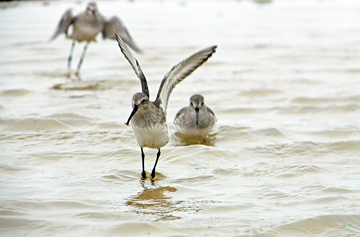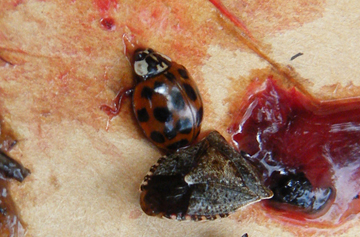Ladybug Washups
Treacherous Baths - Ladybug Washups
Rebecca Smyth & W. Rachel Singley
-- January 2010
Imagine that you are walking along a sandy shoreline and while taking in the natural beauty you notice that the driftwood and other debris are entirely covered in ladybugs! This is no fantasy- thousands of beetles wash up on the shores of lakes and ocean beaches all over the world. The first author to note that ladybugs, in particular, were predominant among them was Thomas J. Bold (1873) who wrote, “Visitors to our local [Britain] watering places must have noticed occasionally the sudden appearance of swarms of Lady-birds of various kinds. One of these, Coccinella 11-punctata, not rare generally, will some years appear in such profusion that every stone, brick, or clog of wood lying on the sandy bents will be reddened by congregated hundreds, but where they have come from, and why, is one of those perplexing questions which it is impossible to answer satisfactorily.”
The phenomenon is called just what it is, a ladybug washup, and anywhere from hundreds to thousands, even millions of ladybugs can end up on the banks and shores of lakes and coastal areas.

Dunlins picking ladybugs along the beach in Chicago, October 2009, photographed by Steve Spitzer.

Harmonia axyridis gutted from a rainbow trout at Lake Winnipesaukee NH, May 2009, by Florence Dickie
We expect to see ladybugs walking along leaves, finding aphids or other soft-bodied insect prey, in grasses, bushes or trees in the spring and summer, and then crawling through cracks and crevasses into our homes in late fall and winter. But we are not used to seeing these common garden insects in an aquatic habitat, let alone swimming or floating en masse. The ladybugs are sometimes still alive, but many are found dead, having drowned before they reached shore.
Still debated are the questions of how and why the ladybugs come to gather on shorelines, and how long they can float. Ideas fall into two categories: those based on ladybugs floating to shore, and those suggesting that ladybugs are gathering at the shore from land. Either route would require large numbers of ladybugs to simultaneously take flight. Synchronized flight could happen while gathering or dispersing from over-wintering sites, or perhaps could be the result of rapid growth in ladybug populations and subsequent depletion of resources. Ladybugs could be setting off to forage. If we think that the ladybugs are coming from land to the shore, then hungry ladybugs may go to the shores to drink (Hodek et al. 1993), or gather at the shore because of reluctance to cross the water (Nalepa et al. 1998) (historical research Denemark and Losey in press).
Alternatively, the idea that ladybugs are blown or knocked into the water and then drift ashore has been suggested by several authors (e.g. Lee 1980, Schaefer et al. 1987, Turnock 1996, Acorn 2007). Many of these noted the correlation with what were termed "warm" afternoons. As early as 1900 James G. Needham observed a washup of 35 ladybug species on the shore of Lake Michigan which he believed had been caused by a serious thunderstorm the day before. Most recently, a former undergrad in John Losey's lab at Cornell University, Eric Denemark, has contributed empirical data supporting the hypothesis (Isard et al. 2001) that a specific type of wind, not necessarily a big storm, called a lake or sea breeze, is key to understanding how ladybug washups come about.
Lake and sea breezes are caused by differential heating and cooling of water and land, for example, when the air is especially warm, but the water is still cold. Isard et al. (2001) pointed out that these breezes can be affected by several local variables and can happen on a daily basis, or never, in some localities. Eric found that some ladybugs could float for over 150 hours and estimated the average time floating for washups in the Finger Lakes to be about 33 hours. His work correlated seasonal changes in the probabilities of lake breezes and of washups and the tempo of lake breezes and ladybug floating distances. Eric's was the first study of ladybug washups in the New York Finger Lakes. He showed that washups can occur by relatively small bodies of water and that the numbers of ladybugs caught in washups broadly correlates with the size of the bodies of water. This, too, would be consistent with lake and sea breeze causes.
Eric is now in graduate school in the Entomology Department at Texas A & M University and his paper was recently published in Entomologica Americana (Denemark and Losey 2010).
References:
Acorn J. 2007. Ladybugs of Alberta: Finding the Spots and Connecting the Dots. University of Alberta Press. Edmonton, Alberta, Canada.
Bold T. J. 1873. Note on the recent occurrence in Northumberland and Durham of the Camberwell Beauty Butterfly. Tyneside Naturalists’ Field Club, Transactions of the Natural History Society of Northumberland, Durham and Newcastle upon Tyne. 5: 30-34.
Isard, S., Kristovich, D., Gage, S., Jones, C., and N. Laird. 2001. Atmospheric motion systems that influence the redistribution and accumulation of insects on the beaches of the Great Lakes in North America. Aerobiologia Vol. 17, 275-291.
Lee. R. E. 1980. Aggregation of Lady Beetles on the shores of lakes (Coleoptera: Coccinellidae). American Midland Naturalist. 104, 295-304.
Nalepa, C. A., K. Ahlstrom, B. Nault, and J. Williams. 1998. Mass appearance of lady beetles (Coleoptera: Coccinellidae) on North Carolina beaches. Ent. News 109(4) 277-281.
Needham, J. J. 1900. Insect drift on the shore of Lake Michigan. Occas. Mem. Chicago. Entomol. Soc. 1: 19-26.
Oliver, F. W. 1943. A swarm of ladybirds (Coleoptera) in the Libyan desert coast of Egypt between Hamman and Abusir. Proc R. Entomol. Soc. Lond. Ser. A. Gen. Entomol., 18: 87-88
Schaefer, P. W., R. J. Dysart and H. B. Specht. 1987. North American distribution of Coccinella septempunctata (Coleoptera: Coccinellidae) and its mass appearance in coastal Delaware. Environ. Entomol. 16: 368-373
Turnock, B. 1996. Lady beetles on the Lake Manitoba beach. UFS (Delta Marsh) Annual Report. Vol. 31.
Blog entries are also a good place to find people who have witnessed washups first hand, and they usually have a few pictures of what they saw. Though these accounts are not as reliable as scientifically collected data, blog entries are a great way to track ladybug washup sightings.
Below are links to just a few blog entries that report the amazing sight of thousands of ladybugs.
LINKS:
http://sloblogs.thetribunenews.com/sidetracked/2009/04/21/ladybugs-invade-pismo-beach/
http://beach.freedomblogging.com/2008/04/18/ladybugs-bug-out-beachgoers/
http://www.fullcirc.com/weblog/2005/10/ladybugs-on-beach-and-devils-river.htm
